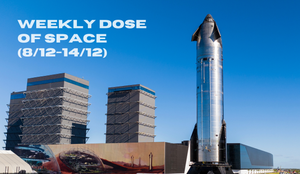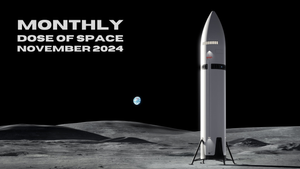
Weekly Dose of Space (13/10-19/10)
Welcome back to Weekly Dose of Space! This week had seven orbital launches occur, with most of them carrying satellites for mega-constellations. News this week had Axiom unveiling its AxEMU spacesuit, yet more delays for Starliner, the Artemis Accords gaining another member, and NASA's TDRS system nearing capacity. As always, we'll also look ahead to what the worldwide launch schedule might look like next week.
SpaceX
This week at Starbase began on October 13th when the fifth flight test of Starship-Super Heavy occurred. Almost seven minutes after launch, Booster 12 returned to the launch site and was caught by the launch towers 'chopsticks'.

After having caught Booster 12, the 'chopsticks' lowered the booster onto the Orbital Launch Mount. The 14th had teams remove the booster flight termination system explosives removed. October 15th had Booster 12 removed from the Orbital Launch Mount, placed onto a transport stand, and then moved to the production site.
On October 17th, a few days after Booster 12 left the launch site, the Orbital Launch Mounts alignment pins were reinstalled. These pins are used to fine-tune the placement of Super Heavy boosters during stacking, ahead of testing or flight. The 17th also saw the 'chopsticks' open and move for the first time since catching Booster 12 on flight five.
Launches This Week
October 13th - Starship-Super Heavy for Flight 5
Starting off this week strong was Starship-Super Heavy's fifth flight test from SpaceX's launch site near Boca Chica, in south Texas. The flight test had Super Heavy Booster 12 successfully perform the first catch between the launch towers 'chopsticks' while Ship 30 splashed down in the Indian Ocean after passing through atmospheric reentry in one piece. More details about this flight are available here.

October 14th - Falcon Heavy with Europa Clipper
Falcon Heavy launched from Launch Complex 39A on October 14th carrying NASA's Europa Clipper spacecraft to an Earth-escape, beginning its journey to Jupiter's moon Europa. Details about this mission are available here.
Supporting this launch were boosters B1089, flying for the first time, B1065, flying for the sixth time, and B1064, also flying for the sixth time.

October 15th - Falcon 9 with Starlink Group 10-10
SpaceX launched a batch of twenty-three Starlink satellites from Space Launch Complex 40, in Florida, atop of Falcon 9. The booster for this mission was B1080, flying for the eleventh time, and landing downrange on the drone ship 'A Shortfall Of Gravitas'.

October 15th - Falcon 9 with Starlink Group 9-7
Another batch of twenty Starlink satellites were launched atop of Falcon 9 from Space Launch Complex 4E, in California. The booster supporting this mission was B1071, making its nineteenth flight, and landing on the drone ship 'Of Course I Still Love You' downrange.
Falcon 9’s first stage booster lands for the 19th time ahead of recovery and refurbishment for its next mission pic.twitter.com/I7LO8wLWmK
— SpaceX (@SpaceX) October 15, 2024
Falcon 9 booster B1071 landing on the drone ship 'Of Course I Still Love You', via SpaceX on X.
October 15th - Long March 6A with Qianfan Polar Group 02
A Long March 6A launched a second batch of eighteen Qianfan satellites to a polar orbit from the Taiyuan Satellite Launch Center, in the north of Shanxi province.

October 16th - Long March 4C with Gaofen-12 05
The Gaofen-12 05 satellite was launched from the Jiuquan Satellite Launch Center atop of a Long March 4C. Following launch, Gaofen-12 05 was tracked to a 586 by 599-kilometer 97.9-degree orbit.

October 19th - Falcon 9 with Starlink Group 8-19
Falcon 9 launched another batch of twenty Starlink satellites to low Earth orbit from Space Launch Complex 40. Supporting this mission was booster B1076, flying for the seventeenth time, and landing downrange on the drone ship 'Just Read The Instructions'.
In Other Space News
Axiom unveils lunar spacesuit design

While at the 75th International Astronautical Congress in Milan, Italy, Axiom Space and Prada unveiled the flight design of the Axiom Extravehicular Mobility Unit (AxEMU) spacesuit. The suit will be used for the first time on the lunar surface as part of the Artemis III mission in 2026, but more likely in 2028.
Axiom Space and Prada jointly developed the materials used in the spacesuit to bring together in-depth knowledge and experience on materials and production processes along with engineering expertise. As part of the reveal, Matt Ondler, Axiom Space's President, said the following about the partnership:
“Our elite teams have redefined spacesuit development, establishing new pathways to innovative solutions and applying a state-of-the-art design approach for the AxEMU. We have broken the mold. The Axiom Space-Prada partnership has set a new foundational model for cross-industry collaboration, further expanding what’s possible in commercial space.”
According to Axiom Space, the AxEMU spacesuit provides increased flexibility, performance, and safety, as well as specialized tools for exploring the Moon's south pole. Axiom's suits will also fit a wide range of crewmembers.
Currently, the AxEMU suit is believed to be undergoing testing at NASA's neutral buoyancy facility as well as integrated tests with the Artemis Lunar Terrain Vehicle prototypes. The suit is expected to enter a critical design review in 2025.
First operational Starliner mission moved to 2026
NASA announced on October 15th that both U.S. crew rotation missions to the International Space Station for 2025 would be flown by SpaceX, as the Crew-10 and Crew-11 missions.
The agency had been hoping to assign one of these missions to Boeing's Starliner, but the decision to return its astronauts on a separate spacecraft has delayed the first operational mission. NASA's rationale for pushing the first operational flight to 2026 is as follows:
"The timing and configuration of Starliner’s next flight will be determined once a better understanding of Boeing’s path to system certification is established. This determination will include considerations for incorporating Crew Flight Test lessons learned, approvals of final certification products, and operational readiness." – "Meanwhile, NASA is keeping options on the table for how best to achieve system certification, including windows of opportunity for a potential Starliner flight in 2025."
While no firm path forward was stated, Starliner may likely have to fly another test mission to the International Space Station. NASA may also want to see an end-to-end mission with crew onboard to certify the spacecraft.
So far Starliner has flown three times. The first time for Orbital Flight Test-1, which failed to reach the space station, the second time for Orbital Flight Test-2, which flew a largely successful mission to the space station, and the third time for Crew Flight Test-1, which had to return uncrewed.
Estonia signs Artemis Accords
On October 13th Estonia signed onto the U.S.-led Artemis Accords. Erkki Keldo, Estonia’s minister of economy and industry, signed the agreement on behalf of the country. Keldo said the following after the signing:
“Estonia is well known as the leading country in e-governance, and it is a great honor for us to enter a next level in space exploration" – “We are more than interested to share our knowledge with the global space community to make future collaboration in space exploration a success for humankind. I am sure that joining the Artemis Accords will open attractive opportunities to Estonian enterprises too, to share their valuable knowledge and competences.”
Estonia is the forty-fifth nation to sign the agreement, joining Australia, Canada, Italy, Japan, Luxembourg, the United Arab Emirates, the United Kingdom, the United States, Ukraine, the Republic of Korea, New Zealand, Brazil, Poland, Mexico, Israel, Romania, Bahrain, Singapore, Colombia, France, Saudi Arabia, Nigeria, Rwanda, the Czech Republic, Spain, Ecuador, India, Argentina, Germany, Iceland, the Netherlands, Bulgaria, Angola, Belgium, Greece, Uruguay, Switzerland, Sweden, Slovenia, Lithuania, Peru, Slovakia, Armenia, and the Dominican Republic.
NASA's TDRS system near capacity
Via Satellite reported on October 16th that NASA's Tracking and Data Relay Satellite system will stop onboarding new missions to the network, effective November 8th.
NASA's Tracking and Data Relay Satellite, commonly abbreviated to TDRS, network is used to communicate with the Hubble space telescope and International Space Station, among many other spacecraft. A dozen satellites were launched for the network between 1983 and 2017.
Speaking to Via Satellite, Julian Coltre, public affairs officer for NASA’s Space Communications and Navigation program, explained that future missions that have already set up services to work with TDRS can still use NASA's Near Space Network to communicate directly with Earth, but limiting communication time.
NASA is currently working on transitioning to a commercially owned and operated satellite communications services for near-Earth missions. The agency's reasoning for the transition is to utilize the U.S. industry’s investment in satellite communications and become one of many customers.
What to Expect Next Week
Starbase
It's currently unknown when the next test flight of Starship-Super Heavy will occur, but the license for flight five does allow for another flight if no major alternations are made to the flight plan. Super Heavy Booster 13 and Ship 31 have already undergone some pre-flight testing, likely allowing for a much shorter wait to the next flight.
October 20th - Falcon 9 with OneWeb 20
Falcon 9 is believed to be targeting a launch from Space Launch Complex 4E with twenty satellites for OneWeb's satellite internet constellation.
October 21st - Falcon 9 with Starlink Group 6-61
SpaceX is expecting to launch a batch of Starlink satellites to low Earth orbit atop of Falcon 9 from Space Launch Complex 40. The booster supporting this mission is currently unknown, but it will target a landing downrange on one of SpaceX's drone ships.
October 26th - H3 with DSN-3
Japan's H3 launch vehicle is expected to launch the DSN-3 satellite to geostationary transfer orbit from the Tanegashima Space Center. This satellite will be used for Japanese military communications.




